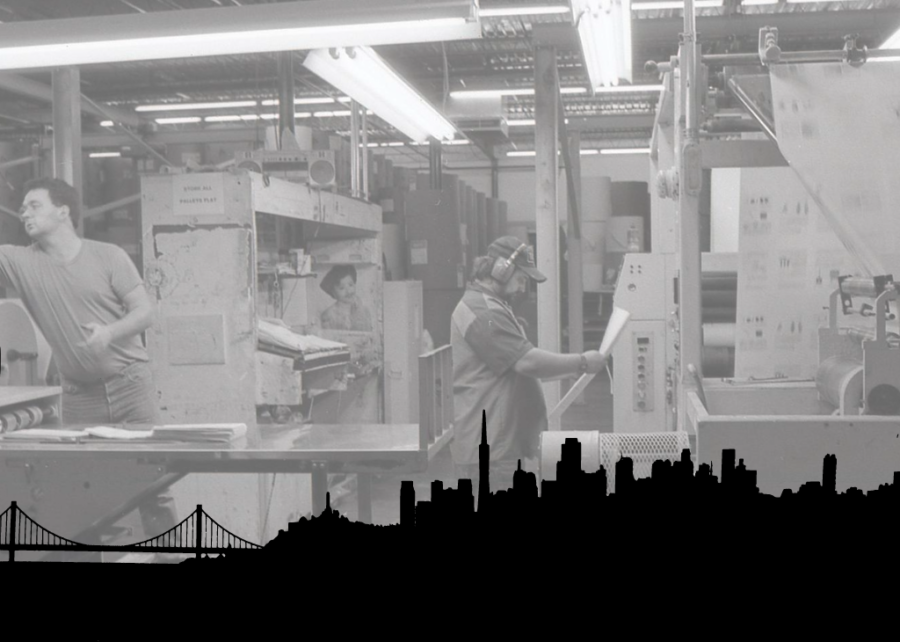San Francisco’s economics leaves the working class unsatisfied
San Francisco’s economy is leading to struggles for the working class to survive.
March 27, 2023
San Francisco’s working class is struggling. The increase in various costs while wages remain stagnant is causing San Franciscans to be priced out.
Between 1973 and 2013, hourly compensation for the American working class increased by 7 percent while productivity increased by 74 percent, according to Wage Stagnation in Nine Charts. The cost of Living in the Bay Area in 2015 is 27 percent greater than the average household income, according to BayAreaEconomy.
In San Francisco, the median home value in 2020 was $1,100,000 with an annual income of $119,136, a 10 to 1 ratio, according to the Census and “Track home prices in every Bay Area city and ZIP code.” The unemployment rate is 2.6 percent in Sept. 2022, according to BLS.
Most of San Francisco’s economic problems are nationwide and can be solved federally, but state or local governments can also implement solutions. Part of the solution is having minimum wages increase automatically according to each region’s inflation. Another would be for the government to somehow support projects to make suburban places more urban to help the growing wave of suburbanization.
Gig economies should be required to pay people more and stop exploiting loopholes, as stated in “Is everything turning into uber.” Also, various economists should be consulted to reduce the debt-to-GDP ratio below 300 percent as stated in “Visualizing the US Debt Crisis.” And the government should regulate investing to stop investments in companies that are significantly unprofitable or a scam, as stated in “Why silicon valley and Shenzhen have exactly the opposite problem.”
The government should also ban redlining, ban poor areas subsidizing the middle class, and use welfare to negate the effects of discriminating against poor areas. In addition, single-family home zoning should be banned and the government should support funding public transportation to accommodate an increase in dense population and commerce from supporting mixed-use walkable neighborhoods, historical commercial areas, and downtown; as suggested in Not Just Bikes’ video series on Strong Towns.
An increase in public transport would substitute expensive car costs with cheaper public transportation costs, and denser housing would drastically decrease infrastructure costs. Housing costs can also be decreased by banning golf courses within a mile of whatever is considered a metropolitan area and building housing there instead, as encouraged by 10 Cities That Devote Prime Urban Land to the Lowest, Worse Use.
Housing regulations are too strict and costly, so we need to loosen definitions of historical homes, make mixed-use housing and tiny homes lacking full infrastructure legal, and make permits less necessary, cheaper, and faster. This would result in more homes being built, as explained in “America’s Looming Housing Crisis” and “The Housing Crisis is the Everything Crisis.” Housing should also never be an investment, but be a right that you can pay to upgrade along with food and water, as suggested in “The Housing Affordability Crisis We Don’t Want to Solve.” We could also implement some sort of competent government-run housing project that allows renting and purchasing that outcompetes price gouging landlords and investors who are landlords, as somewhat suggested in “Are Landlords Really That Bad?” A solution that wouldn’t work is a housing limit or rent control, because that encourages people to reach the limit as they do in China and S.F., which is a massive problem.
The unemployment rate is nearly unfixable and worsening with automation, according to “How Capitalism Ruined Work,” but it can be helped with a mix of socialist and Neoliberal solutions rather than current neoliberal politics. America can implement more government employment and lessen working hours, which doesn’t lessen productivity significantly until we have a better work-life balance and fix the drop in productivity through more employment. Unfortunately, low unemployment increases inflation, according to “The Great Labor Shortage Crisis”
The wealthy should be taxed more through increasing income tax in high tax brackets, increasing restrictions, stopping loopholes, and making more tax brackets for the top one percent and top 100 or something similar. This is to solve how with all tax types combined, the top one percent pay the least in taxes, as stated in “Who pays the lowest taxes in the US.”This would stop capitalists from stealing from the working class and distributing wealth to workers, as explained in “How American Workers Are Losing Billions.” “These companies with no CEO are thriving” proves that besides self-employment, citizens should be in co-ops, which are successful and happy companies, unless the structure can’t be implemented.
California also needs to somehow create and encourage more stable jobs, which the tech industry is not one of. Finally, to not die off like the rust belt, California needs to not be overly reliant on tech and adapt to new industries. This is especially important with internet communication encouraging Silicon Valley to live elsewhere.
Citizens should encourage these propositions with amendments. Non-governmental solutions include protesting, petitioning, supporting good companies, and campaigning. The main limit to these solutions is finding out how to implement them and better spend taxes, which are already so high they scare wealthy corporations and their tax payments away from S.F., C.A., and U.S.A. to places like tax havens. The more these laws are passed, the better the working class will be, especially in San Francisco, and politicians need to anticipate the decline of tech.













